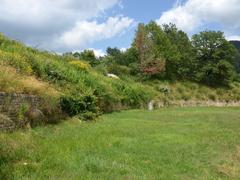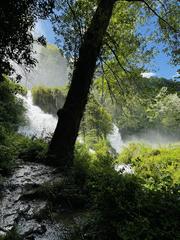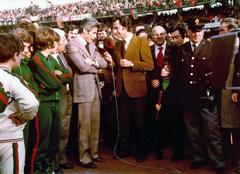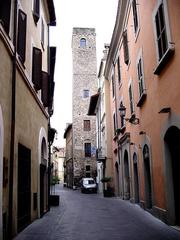Complete Guide to Visiting the Convent of San Francesco in Terni, Italy: Visiting Hours, Tickets, and Nearby Attractions
Date: 14/06/2025
Introduction: The Significance of the Convent of San Francesco in Terni
Located in the heart of Terni, Umbria, the Convent of San Francesco is an enduring symbol of Franciscan spirituality, medieval and Renaissance artistry, and the region’s layered cultural identity. Established in the 13th century and closely associated with St. Francis of Assisi, this historic site began as a modest oratory bequeathed by Bishop Rainerio to St. Francis, setting the stage for centuries of religious devotion and community engagement (Exploring Umbria; ilcastellano.eu).
The convent’s architecture harmoniously blends Gothic austerity with Renaissance elegance, featuring spongy travertine stonework, a three-nave basilica layout, and a vibrant bell tower adorned with polychrome majolica tiles—an iconic work by Antonio da Orvieto (Comune di Terni; Umbriatourism.it). Its interiors house masterpieces such as the Paradisi Chapel frescoes by Bartolomeo di Tommaso, which vividly narrate the Last Judgment and reflect the flourishing of Umbrian Renaissance art (Comune di Terni).
Today, the convent remains an active spiritual center, a key stop along the Way of St. Francis pilgrimage route, and a lively hub for cultural events and social outreach (ilcastellano.eu; diocesi.terni.it). This guide presents a comprehensive look at its history, architecture, visitor information, and the many ways you can experience the living legacy of San Francesco in Terni.
Contents
- History and Franciscan Origins
- Architectural and Artistic Highlights
- Visiting Information: Hours, Tickets, Accessibility
- Spiritual and Community Life
- Practical Tips and Amenities
- Surrounding Attractions
- Frequently Asked Questions (FAQ)
- Recommendations for Visitors
- Official Sources and Links
History and Franciscan Origins
The Convent of San Francesco’s origins trace back to the early 13th century, intimately connected with the travels and ministry of St. Francis of Assisi. Tradition holds that the original oratory on the site was donated by Bishop Rainerio, allowing St. Francis and his followers a place of shelter and contemplation in Terni (Exploring Umbria). Construction of the church began in the latter half of the 1200s, establishing a single-nave Gothic structure with a transept and polygonal apse, built from the distinctive “sponga” travertine stone (Comune di Terni).
In the 15th century, the church expanded to include two side aisles, creating the current three-nave basilica. Materials repurposed from the dismantled Arco del Fondanello were incorporated, reflecting resourcefulness and the evolving needs of the growing Franciscan community. The Renaissance era saw the addition of a monumental apse and lateral chapels, while the bell tower—constructed in 1445—became a defining feature of Terni’s skyline, celebrated for its polychrome majolica tiles (Comune di Terni).
The Paradisi Chapel, commissioned by the influential Paradisi family, stands as a testament to the convent’s artistic patronage. Its frescoes by Bartolomeo di Tommaso (c. 1450) depict the Last Judgment, Paradise, and Hell, and are considered masterpieces of Umbrian Renaissance art (Comune di Terni).
Over the centuries, the convent has undergone Baroque refurbishments, 19th- and 20th-century restorations, and was designated a National Monument due to its historical and artistic significance.
Architectural and Artistic Highlights
Façade and Structure:
- Gabled façade with a central tympanum and decorative arches.
- Three naves, with the original nave and two later additions (1437), reflecting architectural evolution (umbriatourism.it).
Bell Tower:
- Designed by Antonio da Orvieto (1445), it features vibrant green and blue majolica tiles, unique in the region.
Paradisi Chapel:
- Houses a renowned cycle of Last Judgment frescoes by Bartolomeo di Tommaso, illustrating Paradise, Hell, and the resurrection of the dead.
Chapels and Interior:
- The Chapel of San Bernardino da Siena honors the founder of the Observant Franciscans.
- Baroque altars in the lateral chapels add decorative richness.
Cloisters and Library:
- The convent’s original complex included cloisters, a library, and monastic spaces, supporting both spiritual and scholarly pursuits.
Visiting Information: Hours, Tickets, Accessibility
Visiting Hours:
- Generally open Tuesday to Sunday from 9:00 AM to 6:00 PM; closed Mondays and some holidays (Comune di Terni).
- Some sources note specific hours: 9:00 AM–12:30 PM and 3:00 PM–6:00 PM, Monday through Saturday (ospitalitareligiosa.it).
- Always confirm current opening times before your visit.
Tickets and Admission:
- Entry is generally free, with donations welcome for maintenance and community activities.
- For special exhibitions or guided tours, a modest fee may apply.
Guided Tours and Audio Guides:
- Guided tours (often in multiple languages) and audio guides are available. Booking in advance is recommended for groups.
Accessibility:
- The convent and church are accessible to visitors with disabilities, with adapted entrances and facilities.
Location and Transport:
- Centrally located in Terni, within walking distance from the train station and city center.
- Essential services (pharmacy, supermarket, restaurants, ATM) are nearby.
Spiritual and Community Life
The Convent of San Francesco is an active religious and cultural center. Regular Masses, diocesan celebrations, and liturgical feasts, such as the annual celebration of San Giovanni Bosco, are held here (diocesi.terni.it). The convent welcomes pilgrims, tourists, and local residents for spiritual retreats, prayer meetings, and community events (ospitalitareligiosa.it).
Additionally, the convent is involved in social outreach, charitable initiatives, and cultural programming that reflect the enduring Franciscan mission of humility, service, and inclusion (ilcastellano.eu).
Practical Tips and Visitor Amenities
- Dress Code: Modest attire is required—shoulders and knees should be covered.
- Photography: Permitted in most areas without flash. Please avoid photography during services.
- Accommodation: The convent offers lodging for pilgrims and visitors on a donation basis. Contact ahead to inquire about availability.
- Visitor Facilities: Accessible restrooms, nearby dining options, and essential services are available within a short walk.
Surrounding Attractions
Enhance your visit by exploring Terni’s other highlights:
- Historic Center: Medieval streets, shops, and lively piazzas (lovelycamel.com).
- Cascata delle Marmore: A spectacular waterfall just outside the city.
- Roman Amphitheatre and Cathedral of Terni: Key historic sites within the city.
- Umbrian Countryside: Ideal for wine tours, culinary experiences, and outdoor activities, especially in June (wanderlog.com).
Frequently Asked Questions (FAQ)
Q: What are the Convent of San Francesco’s visiting hours?
A: Usually 9:00 AM to 6:00 PM, Tuesday through Sunday. Check ahead for seasonal or holiday changes.
Q: Is there an entrance fee?
A: Admission is generally free; donations are appreciated.
Q: Are guided tours available?
A: Yes, in several languages. Advance booking is advisable for groups.
Q: Is the site accessible for those with disabilities?
A: Yes, with ramps and adapted facilities.
Q: Can I take photos?
A: Photography is allowed in most areas, but please respect religious services.
Q: Can I attend Mass?
A: Yes, regular Masses and special liturgical events are open to the public.
Recommendations for a Memorable Visit
- Plan Ahead: Confirm hours and consider booking a guided tour.
- Engage with Local Life: Attend Mass or a community event for a deeper experience.
- Combine Visits: Pair the convent with Terni’s other historic and natural attractions.
- Respect the Setting: Be mindful of the sacred atmosphere and dress code.
Official Sources and Further Information
- Exploring Umbria
- Comune di Terni
- ilcastellano.eu
- Turismo Comune Terni
- Umbriatourism.it
- ospitalitareligiosa.it
- diocesi.terni.it
- lovelycamel.com
- wanderlog.com
Visual Suggestions:
- Façade of the Convent of San Francesco in Terni
- Paradisi Chapel frescoes inside the Convent of San Francesco
- Polychrome majolica-tiled Campanile of the Convent of San Francesco
Ensure images use descriptive alt text for accessibility and SEO.
Summary & Call to Action
The Convent of San Francesco in Terni is a living monument to centuries of faith, art, and community life in Umbria. From its medieval foundations and Renaissance masterpieces to its ongoing spiritual and social mission, it offers a profound experience for visitors. Plan your visit, explore Terni’s cultural riches, and discover the enduring legacy of the Franciscan tradition. For personalized tours and up-to-date travel resources, download the Audiala app and follow us for more inspiration.



